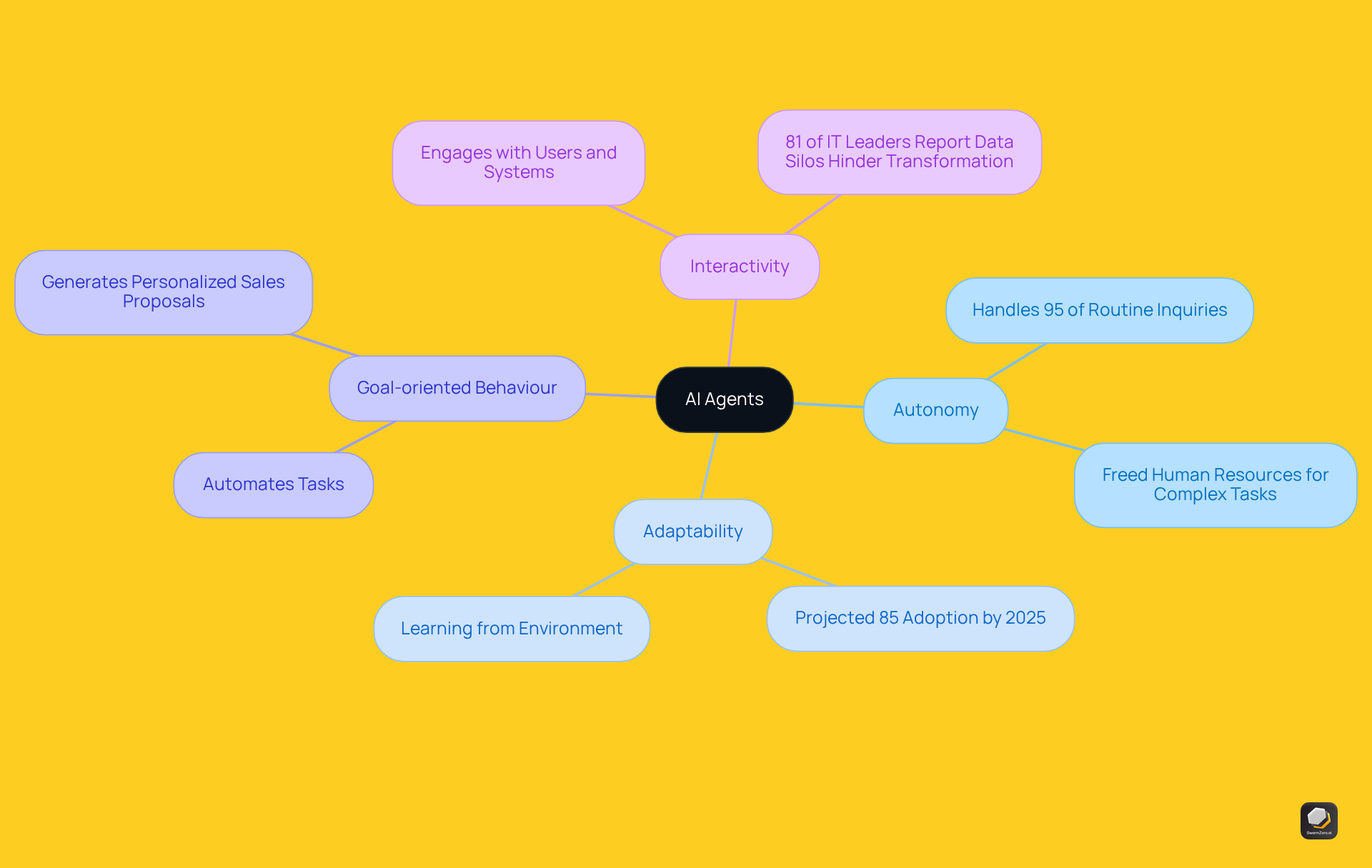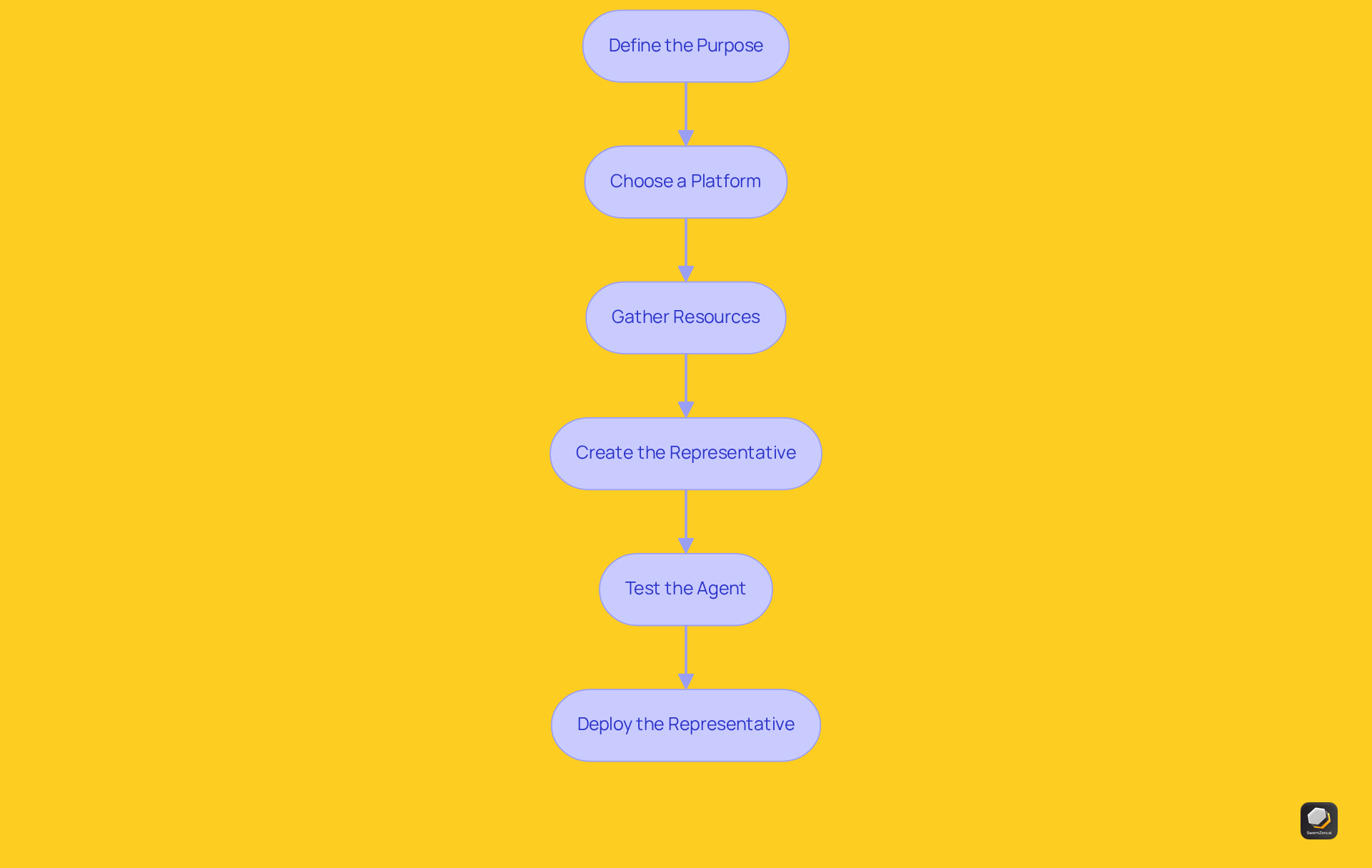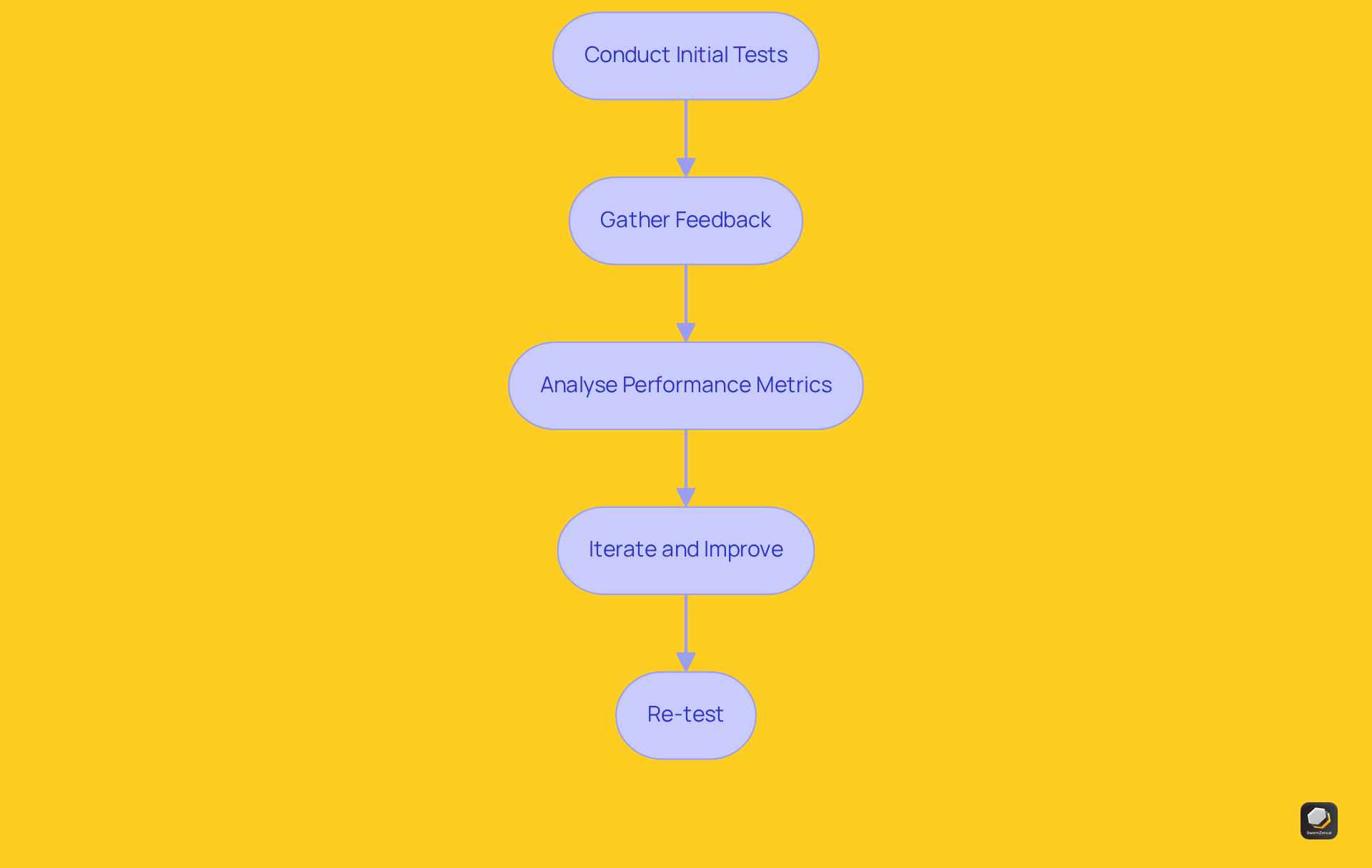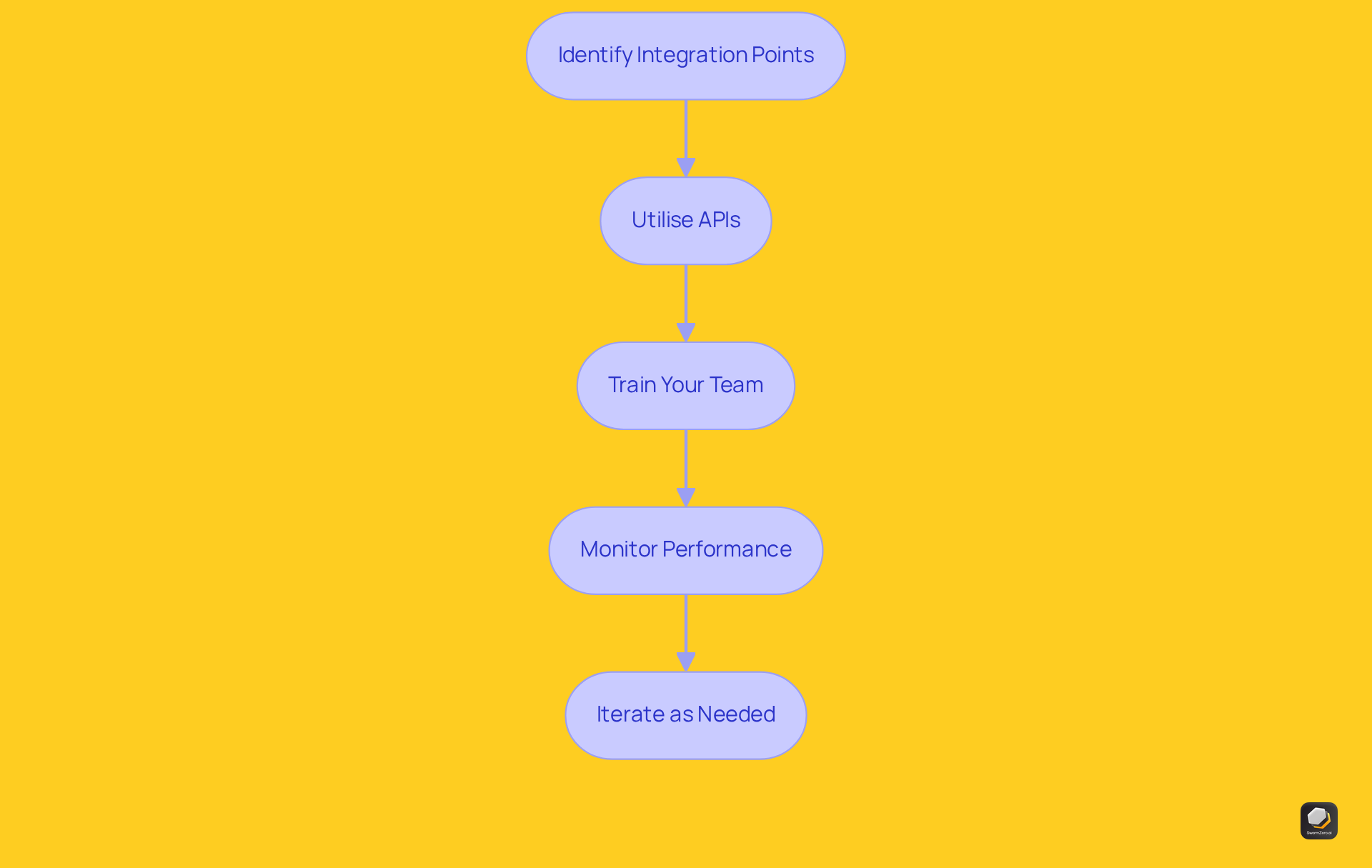How to Create a Simple AI Agent: Step-by-Step Guide
Learn how to create a simple AI agent with this step-by-step guide for enhanced efficiency.

Key Highlights:
- AI agents are autonomous systems designed to perform tasks independently, significantly enhancing efficiency in sectors like healthcare.
- Key characteristics of AI agents include autonomy, adaptability, goal-oriented behaviour, and interactivity.
- The market for AI systems is expected to grow to $47.1 billion by 2030, driven by demand for automation.
- Steps to create an AI agent include defining its purpose, choosing a development platform, gathering resources, creating the agent, testing it, and deploying it.
- Initial testing and user feedback are crucial for ensuring the reliability and effectiveness of AI agents.
- Performance metrics such as response times and client satisfaction are essential for analysing the agent's success.
- Integrating AI agents into existing workflows requires identifying integration points, utilising APIs, training staff, and monitoring performance.
- An iterative approach to development and integration helps maintain the relevance and effectiveness of AI agents.
Introduction
The rapid evolution of artificial intelligence is transforming the operational landscape for businesses, with AI agents at the forefront of task automation and productivity enhancement. As these intelligent systems become increasingly vital across various sectors, grasping the fundamentals of creating a simple AI agent presents a significant opportunity for organisations to streamline operations and boost efficiency.
Yet, the journey from concept to deployment is often riddled with challenges—how can one ensure that their AI agent not only performs effectively but also integrates seamlessly into existing workflows?
This guide offers a comprehensive, step-by-step approach to building and optimising an AI agent, empowering businesses to fully harness the potential of this transformative technology.
Understand AI Agents: Definition and Key Characteristics
AI agents represent sophisticated software systems crafted to autonomously execute tasks on behalf of users, showcasing several key characteristics that significantly enhance their effectiveness:
- Autonomy: Operating independently, AI agents make decisions grounded in their programming and the data they process. This capability allows them to manage up to 95% of routine inquiries in sectors such as healthcare, thereby freeing human resources for more complex activities.
- Adaptability: These systems learn from their environment, refining their performance over time. As organisations increasingly adopt AI agents—projected to reach 85% by 2025—this adaptability becomes vital for maintaining relevance in dynamic business landscapes.
- Goal-oriented behaviour: Designed to achieve specific objectives, AI systems can automate tasks or provide actionable insights. For instance, they can generate personalised sales proposals or automate content creation, which directly impacts productivity and operational efficiency.
- Interactivity: Many AI entities engage with users or other systems, enhancing their functionality. This interactivity is essential, as 81% of IT leaders report that data silos hinder digital transformation, making seamless integration crucial for effective AI deployment.
Understanding these traits is essential for knowing how to create a simple AI agent that effectively meets your requirements. The market for AI systems is projected to reach $47.1 billion by 2030, driven by technological advancements and a rising demand for automation. Embrace these insights to position your organisation at the forefront of this transformative wave.

Follow the Step-by-Step Process to Build Your First AI Agent
To understand how to create a simple AI agent, you need a systematic approach that can significantly enhance operational efficiency when creating your first AI system. Here’s a step-by-step guide:
- Define the Purpose: Clearly articulate the specific task your AI system will perform. This could range from automating customer responses to generating insightful reports. A well-defined purpose is crucial, as it establishes the foundation for the entity's functionality.
- Choose a Platform: Opt for a robust platform that facilitates AI system development. SwarmZero stands out with its intuitive Builder, allowing users to create customised entities efficiently. The platform's ability to integrate with tools like Salesforce and Google Drive enhances its versatility, making it a preferred choice for many businesses.
- Gather Resources: Assemble any necessary data or tools that your representative will require to operate effectively. This may include historical data for training or APIs for integration with other systems.
- Create the Representative: Utilise the platform's features to design your representative, specifying its functions and capabilities. For instance, representatives can be programmed to manage customer inquiries or automate routine tasks, significantly lowering operational expenses and enhancing productivity.
- Test the Agent: Conduct initial tests to verify that the agent performs as intended. This phase is essential for identifying any adjustments required to enhance effectiveness. Successful deployments have shown that thorough testing can lead to a 61% increase in productivity by automating repetitive tasks.
- Deploy the Representative: Once you are satisfied with its performance, deploy your representative into the desired environment. Organisations that have adopted AI systems report significant enhancements in workflow efficiency, with some achieving a 41% rise in click-through rates from tailored campaigns.
By following these steps, you can learn how to create a simple AI agent that effectively harnesses the power of AI tools to streamline operations and enhance your business's overall efficiency.

Test and Optimize Your AI Agent for Performance and Reliability
To ensure your AI agent performs reliably, it is crucial to follow these essential testing and optimization steps:
-
Conduct Initial Tests: Begin by running your programme in a controlled environment to observe its behaviour and identify any potential issues. This initial phase is vital for understanding how the representative engages with individuals and manages tasks.
-
Gather Feedback: Collect insights from individuals or stakeholders to understand their experiences and expectations. User feedback is paramount; 80% of customer experience leaders emphasise the importance of measurable business impact when evaluating AI system effectiveness. Furthermore, 34% of these leaders express confidence that their current automation investments are delivering on that promise, underscoring the necessity for continuous improvement.
-
Analyse Performance Metrics: Utilise analytics tools to measure the representative's performance, focusing on key metrics such as response times, accuracy, and client satisfaction. For instance, a high task completion rate indicates that the AI system can autonomously manage complex processes, while shorter response times enhance overall satisfaction. High sentiment scores also suggest effective communication and alignment with user expectations.
-
Iterate and Improve: Based on the feedback and operational data gathered, make necessary adjustments to enhance the representative's functionality. Regular measurement and adjustment cycles are essential for optimising AI systems, as noted by Pratik Bhavsar, ensuring alignment with business objectives.
-
Re-test: After implementing changes, conduct further tests to verify the effectiveness of the improvements. This iterative process sustains reliability and performance over time, fostering trust and satisfaction among individuals.
By concentrating on these steps, businesses can learn how to create a simple ai agent that enhances their AI systems for reliability, ensuring they effectively fulfil user needs and contribute to overall operational efficiency.

Integrate Your AI Agent into Existing Workflows for Enhanced Efficiency
To effectively integrate your AI agent into existing workflows, consider the following guidelines:
-
Identify Integration Points: Evaluate your existing processes to highlight areas where the AI system can provide value, such as automating repetitive activities or enhancing data analysis. Organisations can pinpoint tasks like scheduling or reporting that are suitable for AI delegation.
-
Utilise APIs: APIs are crucial for linking your AI system with various tools and platforms, facilitating seamless data flow and communication. Approximately 70% of organisations are now leveraging APIs to enhance their AI capabilities, underscoring their significance in modern workflows. For instance, integrating your AI assistant with platforms like Slack or Zendesk can streamline internal support and foster collaboration.
-
Train Your Team: Ensure your team is well-versed in interacting with the AI system and leveraging its features effectively. This training is vital for optimising the representative's potential and ensuring client satisfaction.
-
Monitor Performance: After integration, consistently observe the representative's performance to ensure alignment with operational objectives and fulfilment of customer requirements. Regular assessments can help identify areas for improvement.
-
Iterate as Needed: Stay flexible and ready to make adjustments based on user feedback and evolving business requirements. This iterative approach ensures that the AI agent remains relevant and effective in your workflows.
By following these steps on how to create a simple ai agent, organisations can improve their efficiency and productivity, ultimately leading to better resource allocation and enhanced operational outcomes.

Conclusion
Creating a simple AI agent represents a transformative journey that can significantly enhance operational efficiency and productivity. By understanding the core characteristics of AI agents—such as autonomy, adaptability, goal-oriented behaviour, and interactivity—organisations position themselves to effectively harness the power of AI technology. This foundation not only supports the development process but also ensures that the created agent meets the specific needs of the business.
The step-by-step guide outlined emphasises critical phases, from defining the purpose of the AI agent to testing and optimising its performance. Each step is meticulously designed to ensure that the agent functions as intended while integrating seamlessly into existing workflows. By leveraging platforms like SwarmZero and utilising APIs for integration, businesses can streamline operations and maximise the benefits of their AI systems. Continuous feedback and performance monitoring are essential for refining the agent, ensuring it remains relevant and effective in a dynamic environment.
In conclusion, the integration of AI agents into business processes is not merely a trend; it is a strategic move towards achieving greater efficiency and innovation. Organisations are urged to embrace this technology, following the outlined steps to create reliable and effective AI agents capable of automating routine tasks and providing valuable insights. By doing so, businesses enhance their operational capabilities and position themselves advantageously in an increasingly competitive landscape.
Frequently Asked Questions
What are AI agents?
AI agents are sophisticated software systems designed to autonomously execute tasks on behalf of users.
What are the key characteristics of AI agents?
The key characteristics of AI agents include autonomy, adaptability, goal-oriented behaviour, and interactivity.
How does autonomy benefit AI agents?
Autonomy allows AI agents to operate independently and make decisions based on their programming and processed data, enabling them to handle up to 95% of routine inquiries in sectors like healthcare.
Why is adaptability important for AI agents?
Adaptability is crucial as AI agents learn from their environment and refine their performance over time, helping organisations remain relevant in dynamic business landscapes.
What does goal-oriented behaviour mean for AI agents?
Goal-oriented behaviour means that AI agents are designed to achieve specific objectives, such as automating tasks or providing actionable insights, which enhances productivity and operational efficiency.
How do AI agents interact with users or other systems?
Many AI agents engage with users or other systems, which enhances their functionality and is essential for effective deployment, especially in overcoming challenges like data silos that hinder digital transformation.
What is the projected market growth for AI systems?
The market for AI systems is projected to reach $47.1 billion by 2030, driven by technological advancements and increasing demand for automation.
List of Sources
- Understand AI Agents: Definition and Key Characteristics
- AI Agents in 2025: Expectations vs. Reality | IBM (https://ibm.com/think/insights/ai-agents-2025-expectations-vs-reality)
- Autonomous AI Agents Are Coming: Why Trust and Training Hold the Keys to Their Success (https://salesforce.com/news/stories/ai-training-trust)
- AI Agents Statistics: Usage And Market Insights (https://litslink.com/blog/ai-agent-statistics)
- Autonomous AI Agents: Exploring Their Role (https://neontri.com/blog/autonomous-ai-agents)
- Deep Research AI Agents | NextBigFuture.com (https://nextbigfuture.com/2025/06/deep-research-ai-agents.html)
- Follow the Step-by-Step Process to Build Your First AI Agent
- How To Build The Ultimate AI News Agent In 2025 (https://forbes.com/sites/aytekintank/2025/06/17/how-to-build-the-ultimate-ai-news-agent-in-2025)
- 18 Inspiring Agentic AI Quotes From Industry Leaders (https://atera.com/blog/agentic-ai-quotes)
- 15+ AI Agents Statistics You Need to Know in 2025 (https://azilen.com/blog/ai-agents-statistics)
- AI Agents Statistics & Market Trends For 2025: Growth & Impact (https://allaboutai.com/ai-agents/statistics)
- AI Agent Statistics for 2025: Adoption, ROI, Performance & More (https://plivo.com/blog/ai-agents-top-statistics)
- Test and Optimize Your AI Agent for Performance and Reliability
- What I’ve Learned Testing Dozens Of AI Agents In 2025 (https://forbes.com/sites/aytekintank/2025/04/22/what-ive-learned-testing-dozens-of-ai-agents-in-2025)
- AI Agents: Reliability Challenges & Proven Solutions [2025] (https://edstellar.com/blog/ai-agent-reliability-challenges)
- Mastering Agents: Metrics for Evaluating AI Agents (https://galileo.ai/blog/metrics-for-evaluating-ai-agents)
- Measuring AI Agent Performance: What Metrics Really Matter? (https://loris.ai/blog/measuring-ai-agent-performance-what-metrics-actually-matter)
- Key Metrics for Monitoring AI Agent Performance (https://aiinnovation.tech.blog/2025/03/26/key-metrics-for-monitoring-ai-agent-performance)
- Integrate Your AI Agent into Existing Workflows for Enhanced Efficiency
- From chatbots to collaborators: How AI agents are reshaping enterprise work (https://venturebeat.com/ai/from-chatbots-to-collaborators-how-ai-agents-are-reshaping-enterprise-work)
- Microsoft Build 2025 Brings AI Agents Into Your Workflow (https://simform.com/blog/microsoft-build-2025-announcements)
- AI Agents for Startups: Workflow Automation in 2025 (https://brightter.com/articles/how-ai-agents-are-redefining-workflow-automation-for-startups-in-2025)
- PwC launches AI agent operating system to revolutionize AI workflows for enterprises (https://pwc.com/us/en/about-us/newsroom/press-releases/pwc-launches-ai-agent-operating-system-enterprises.html)
- IBM Study: Businesses View AI Agents as Essential, Not Just Experimental (https://newsroom.ibm.com/2025-06-10-IBM-Study-Businesses-View-AI-Agents-as-Essential,-Not-Just-Experimental)




